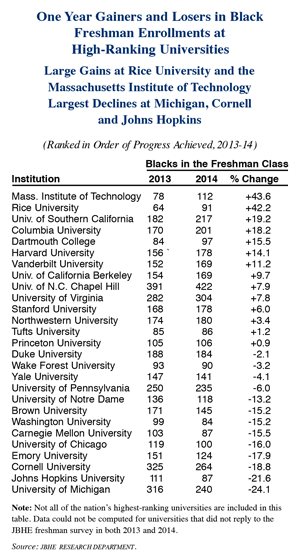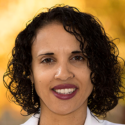![]() Once more, this year The Journal of Blacks in Higher Education has completed its survey of admissions offices at the nation’s highest-ranked research universities. For the 22nd consecutive year, we have calculated and compared the percentages of African-American students in this fall’s entering classes. As in the past, our survey publishes information on the total number of African-American applicants at the various institutions, their acceptance rates, enrollment numbers, and yield rates (the percentage of students who eventually enroll in the colleges at which they were accepted).
Once more, this year The Journal of Blacks in Higher Education has completed its survey of admissions offices at the nation’s highest-ranked research universities. For the 22nd consecutive year, we have calculated and compared the percentages of African-American students in this fall’s entering classes. As in the past, our survey publishes information on the total number of African-American applicants at the various institutions, their acceptance rates, enrollment numbers, and yield rates (the percentage of students who eventually enroll in the colleges at which they were accepted).

Seven years ago Columbia University headed the JBHE rankings for the first time. Now, for the eighth year in a row, Columbia has the highest percentage of Black first-year students among the 30 highest-ranking universities in the nation. There are 201 Black freshmen at Columbia this fall. They make up 14.1 percent of the incoming class.
Only 10 years ago in 2004, Blacks made up only 6.8 percent of the entering students at Columbia University. In 2010, there were 202 Black first-year students at Columbia. They made up 14.5 percent of the incoming students. This was the highest percentage of Black students in the entering class at a leading research university in the history of the JBHE survey.
There is very little difference in the percentage of Black first-year students at the universities ranking second through eighth in our survey. In fact, there is only a 0.3 percentage point difference between the universities ranking second and the university ranking eighth.
Duke University, Harvard University and the Massachusetts Institute of Technology both have first-year classes that are 10.7 percent Black. This ties them for second place in our survey.
Stuart Schmill, dean of admissions at MIT told JBHE that “we are really pleased with the increase this year. We did have a smaller class last year, largely because our yield was lower than in prior years. The students we admit are so extraordinarily talented they are being sought after by many other great schools and they wind up with very many other great choices. It can make the yield unpredictable. Over the course of this past year we redoubled our efforts to communicate with our admitted students, to let them know of the opportunities and our community, and our yield went back up.” MIT’s Black student yield was 68.7 percent this year, compared to 59.1 percent a year ago.
Stanford University and the University of North Carolina at Chapel Hill tied for fifth place in our survey with first-year classes that are 10.6 percent Black.
Vanderbilt University in Nashville, Tennessee, and Yale University in New Haven, Connecticut, also had first-year classes that were more than 10 percent Black.
A decade ago in 2004, only two of the nation’s highest-ranked universities had incoming classes that were more than 10 percent Black. This year there are eight high-ranked universities with an entering class that is more than 10 percent Black. This is a major sign of progress for African Americans at our top universities.
The bottom two places in our survey belong to the University of Michigan and the University of California at Berkeley, universities that are prohibited by state law from considering race in their admissions decisions. Their percentages of Black first-year students are significantly below the level of Black enrollments that existed before that states enacted a ban on race-sensitive admissions.
Gainers and Losers

Last year 20 universities showed gains over the previous year in Black student first-year enrollments. Only eight high-ranking universities showed declines in their number of entering freshmen who are Black. This year, the exact same number of leading universities had increases compared to those who showed declines.
The largest gains were at Rice University in Houston and at the Massachusetts Institute of Technology. Other universities with significant increases include the University of Southern California, Columbia University, Dartmouth College, Harvard University and Vanderbilt University.
The largest percentage declines in the number of Black freshmen occurred at the University of Michigan and Johns Hopkins University. Other universities with significant declines were Cornell, Emory, the University of Chicago, Carnegie Mellon University, Washington University, and Brown University. Brown University ranked second in our survey in 2013. This year, Brown dropped to the 11th position.
A Note on Methodology
Before we continue with the results, it is important to mention how the U.S. Department of Education collects data on the race of undergraduates. Before a change was made several years ago, students who reported more than one race (including African American) were included in the figures for Black students. This is no longer the case. Thus, students who self-identify as biracial or multiracial with some level of African heritage are no longer classified as Black by the Department of Education.
JBHE surveys have always asked respondents to include all students who self-identify as having African heritage including those who are actually from Africa. JBHE has always maintained that biracial, multiracial, and Black students from Africa add to the diversity of a college campus. And including these students in our figures offers college-bound Black students a better idea of what they can expect at a given college or university. In order that we can compare our current data to past JBHE surveys we have continued to asked colleges and universities to include all students who identify themselves as having African heritage.
Black Student Acceptance Rates
It is well recognized that the percentage of Black applicants who actually receive invitations to join the freshman class is a valuable gauge of an institution’s commitment to racial diversity. Yet this figure is regarded as the most sensitive of all admissions data. This is particularly true for some of the very highest-ranked institutions.
Of the 26 highest-ranked universities that responded to our survey, nine declined to reveal their Black student acceptance rates. Unquestionably, public and private litigation threats to affirmative action policies in college admissions have been a factor in producing this sensitivity. With this in mind, admissions officers — who on the whole are solidly supportive of affirmative action — have apprehensions when statistics on Black admissions are made available to the public. There are standard concerns too that racial conservatives on faculties and among alumni and trustees may interpret the figures as suggesting a so-called dumbing down of academic standards and a favoring of “unqualified” Blacks over perhaps more qualified Whites.
But, at the same time it is critical to keep in mind that an institution’s high Black acceptance rate often indicates nothing more than the fact that the admissions office of a given institution has a very strong and well-qualified Black applicant pool.
At 12 of the 17 universities that supplied acceptance rate data to JBHE, the Black student acceptance rate was higher than the acceptance rate for all students. In some cases the differences were significant but larger disparities have been seen in prior surveys. Five of the high-ranking universities we surveyed had Black acceptance rates that were in fact lower than the overall acceptance rate.












When I was a freshman in the 1980s at one of the top five schools in the survey, only six percent of our class was Black. It is encouraging to see the gains in Black freshmen enrollment. Hopefully, in the not too distant future, we’ll see Black first-year enrollment at many of these universities rise to reflect overall national demographics (~13% of US population).
My work in college admissions began in 1966. During the 60’s, 70’s, 80’s, and 90’s lots of research was developed to show the “increase” in Black students. Now, as I read this article I wish this journal would look at this data during this period and see what trends have been established over the past 50 years to determine if indeed we may be even “decreasing” our number of new grad students OR, that that number may not be as large as some by believe. “integration” of these universities really began in the 1960’s. Evaluating our “progress” should begin from this “new” era.
Your yearly survey are great . I would like you to add two more columns in another issue alongside your data. The first column should be the percentage of Asian students in the freshman class. The second column would be the percentage of foreign students in the freshman class.
We put too much focus on the white vs black competition in the US,which I partially understand given the racial history of the nation. A more revealing , and I think important comparison would be blacks vs Asians. Asians are the the most competitive group in the US today, especially when it comes to educational attainment. This comparison is a more cutting edge comparison in my humble opinion.
Keep up the great work !!!!!!
Hey David just a friendly correction (and I may stand corrected) “Asians are the the most competitive group in the US today, especially when it comes to educational attainment.” I think that honor goes to African immigrants who have the highest educational attainment.
In my view, these findings are nothing for anyone to be issuing out higher education accolades at these Historically White Colleges and Universities (HWCUs). For the HWCUs that are know for being “bastions of liberalism” (e.g., UC-Berkeley, UNC-CH, etc.), they should definitely be embarrassed for those dismal numbers of Black Americans enrolled.
By the way JBHE, your analysis would have more validity if you would have “factored in” and reported the percentage of Black American students who belong to the various athletic teams at these HWCUs. I am definitely more interested in the SES background of these Black American students who were admitted. In other words, it has nothing to do with one’s GPA or SAT/ACT score, but, purely economics along with intellectual and social capital and exposure. I am most confident the majority hail from “middle-middle to upper-upper” backgrounds as compared to the lower SES.
Last point, what I find very interesting is how too many degree holding Blacks are so inclined to believe that “we’ve arrived” because Blacks are matriculating at the so-called best HWCUs. Our Black community need to realize that no HWCUs and only a few HBCUs will provide our Black people with the “appropriate education” to solve our problems. For those who dissent, please explain how is it possible for Blacks to have more people with degrees as compared to 40 years ago and yet our overall conditionality is worse when examining all indices.
Let’s not confuse the difference between percentages and absolute numbers in an effort to make it appears as if significant increases have occurred at this well funded Historically White Colleges and Universities (HWCUs)
There have been improvements in both actual numbers and percentages at many of these schools. Of course there is a long way to go. Only one of these large highly rated research universities has Black first-year enrollments that approach the Black percentage of the U.S. population.
What schools chose not to respond to your data request?
Among the liberals arts colleges and major research universities those that did not respond to our request were Middlebury, Colby, Mt. Holyoke, Scripps, and CalTech. Some of these schools object to our survey method which does not directly correspond to the Department of Education’s racial and ethnic classifications. We have chosen to include all students who self-identify as Black whether they are biracial, multiracial, or are from Africa or the Caribbean in our survey. We have been doing so more for more than 20 years and we want to be able to compare our current data to that collected 10 or 20 years ago so that we can assess progress or the the lack of progress. Several years ago the Department of Education changed their reporting requirements and some schools say that they only want to report those official numbers to avoid confusion.
Does the Dept of Ed reporting standards require a breakout of ethnicity/cultural group of Black? I think it’s instructive that when we look at this data that we are able to isolate Blacks that are the descendants of US slaves.
As I’m sure you are aware within the Black grouping immigrants, the children of immigrants and biracial individuals dominate.
On most indicators, the Dept. of Ed. does not offer the data you are looking for. Some Census data is broken down by native-born and foreign-born Blacks.